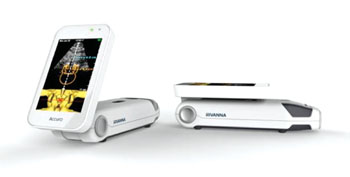Ultrasound System Guides Spinal Anesthesia Needle
By HospiMedica International staff writers
Posted on 18 Jun 2015
A novel handheld device guides clinicians to perform a successful spinal anesthesia injection into the epidural space.Posted on 18 Jun 2015
The Accuro device is an untethered, smart phone-sized ultrasound system that is used to create a three dimensional (3D) volumetric image that can be used to provide navigation to an anatomical target. The self-contained, battery operated device consists of an ultrasound system, an ultrasound probe, and a rotatable touch screen display. The device uses ultrasonic reflections acquired from multiple scans, taken in different planes, to obtain the 3D volume scans needed. The operator only needs one hand to control the device.

Image: The Accuro phone-sized ultrasound system (Photo courtesy of Rivanna Medical).
Anatomical points of interest are recognized via bone-imaging technology and automated image interpretation and depth measurements, which are displayed within the lower part of the screen. Although the device is indicated for spinal anesthesia needle guidance, and is the first ultrasound system designed specifically for that purpose, the company believes the product can be used in a variety of other applications. The Accuro device is a product of Rivanna Medical (Charlottesville, VA, USA), and has been approved by the US Food and Drug Administration (FDA).
“We believe it is a disruptive, game-changing device platform technology, given the significant unmet clinical need for automated image guidance in general, and the spinal anesthesia market in particular” said John A. Williams, President and CEO of Rivanna Medical. “Potential future indications for the device include diagnostic imaging for cardiac and abdominal anatomies.”
Spinal anesthesia is a form of regional anesthesia involving injection of a local anesthetic into the subarachnoid space, generally through a fine needle about nine centimeters long; extremely obese patients require longer needles. It differs from epidural anesthesia in at that the injected dose for an epidural is much larger and that while in an epidural, an indwelling catheter may be placed that obviates additional injections later, a spinal is almost always a one-shot procedure. Also, an epidural may be given at a cervical, thoracic, or lumbar site, while a spinal must be injected below L2 to avoid piercing the spinal cord.
Related Links:
Rivanna Medical














